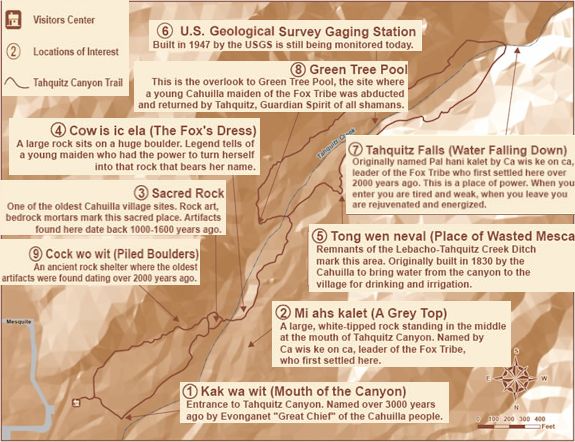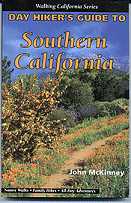After a 30-year closure, the lovely canyon named after a banished Cahuilla shaman called Tahquitz has reopened on a limited basis to hikers in Palm Springs. Tribal rangers lead daily hikes through the storied canyon, which is two miles as the phainopepla flies southwest of downtown.

At the new Tahquitz Canyon Visitor Center, hikers are ushered into a screening room for the “Legend of Tahquitz Canyon” video, then led onto the trail. Groups wind past ancient rock art, diverse desert flora and sometimes wildlife, including the phainopepla, a small bluish-black bird of the Southwest. Another highlight is the 60-foot waterfall featured in Frank Capra’s 1937 film “Lost Horizon,” starring Ronald Colman and Jane Wyatt.
As legend has it, the shaman Tahquitz first practiced his art here to good effect but soon became increasingly mischievous, then downright dangerous, and to this day he consumes people’s souls.
Some tribal members refuse to enter the canyon. So powerful is Tahquitz, believers say, that he can suddenly appear in downtown Palm Springs or manifest himself as an earthquake or a fireball in the sky.
The Agua Caliente Band of Cahuilla Indians closed the canyon to the public in 1969 after a rowdy crowd left a rock concert and descended into Tahquitz Canyon for days of partying. In the years that followed, “No Trespassing” signs, locked gates and fences slowed–but did not stop–visitors.
Most of the hikers and skinny-dippers enjoyed the picturesque falls and respected the serene scene, but vandals dumped garbage on the canyon floor and spray-painted graffiti on the boulders. Hippies, hermits and homeless people took up residence in the canyon’s caves.
The Cahuilla built a visitor center with educational and cultural exhibits and, after a three-year cleanup, reopened the canyon about a year ago. By allowing only guided hikes, the tribe wants to “keep the bad people out and let the good people in,” said tribal ranger Robert Hepburn.
The canyon is full of native plants, including brittle bush, creosote, cholla, hedgehog cactus, ephedra (also called Mormon tea) and desert lavender. Tour leaders detail the many ways the Cahuilla used the plants for food and medicine.
Smog sometimes obscures the view down-canyon, but up-canyon vistas are glorious. From Tahquitz Peak, a subsidiary summit of Mt. San Jacinto, a lively creek tumbles through an impressive gash in the towering rock walls.
The visitor center opens at 7:30 a.m. daily. I recommend starting early and arriving in time to watch the rising sun probe the dark recesses of Tahquitz Canyon. If you take the 8 a.m. tour, the first of the day, you’ll beat the crowds, avoid the heat and have the best chance of spotting wildlife.
At just two miles long, the hike is family friendly. But because it’s an interpretive hike that proceeds slowly, it’s not suitable for young children, particularly those younger than 6. They won’t appreciate the ranger’s narrative and may become a distraction to other hikers.
One alternative is a self-guided hike through one of the other Indian Canyons, nearby Palm Canyon, where you can see a huge collection of California fan palms.
Tours depart from the Tahquitz Canyon Visitor Center at 8 a.m., 10 a.m., noon and 2 p.m. daily. The cost is $12.50 for adults and $6 for children 12 and under. Reservations are recommended.
From downtown Palm Springs, follow California 111 (Palm Canyon Drive) south to Mesquite Avenue. Turn right (west) and proceed half a mile to the parking area below the Tahquitz Canyon Visitor Center.
About the Author:
Acclaimed nature writer and native Californian John McKinney is a lifelong hiking enthusiast who attributes much of his love of the wilderness to his early experiences as a Scout. One of his earliest narratives was “A Walk Along Land’s End,” which recounts his 1,600-mile solo trek the length of the California coast. In 1994, McKinney and his wife, fellow writer Cheri Rae, were one of the major forces behind the movement to give the Mojave Desert area its present status as one of California’s newest National Preserves.
McKinney and his wife live in Santa Barbara, California with their two children.
or more of John McKinney’s tips, visit his website at www.thetrailmaster.com.
Further Reading:
 Day Hiker’s Guide to Southern California by John McKinney
Day Hiker’s Guide to Southern California by John McKinney
Acclaimed nature writer, John McKinney takes us on 150 of his favorite hikes in Southern California’s still pristine and wild areas. Both novice and experienced hikers will find a wide array of outings–nature hikes, family walks and all-day adventures–in McKinney’s trusted and comprehensive 336-page book.
A Guide to Rock Art Sites : Southern California and Southern Nevada by David S. Whitley
Written by one of the US’s foremost experts on prehistoric art, this field guide to southern California and southern Nevada’s Native American rock art provides an extensive introduction to understanding and appreciating rock art, followed by discussion of and directions to 38 sites, all open to the public. Color maps and superb color photographs. Annotation c. by Book News, Inc., Portland, Or.
 A Hiker’s Guide to California Native Places : Interpretive Trails, Reconstructed Villages, Rock-Art Sites and the Indigenous Cultures They Evoke
A Hiker’s Guide to California Native Places : Interpretive Trails, Reconstructed Villages, Rock-Art Sites and the Indigenous Cultures They Evoke
by Nancy Salcedo
This guide takes you on 105 walks in locales steeped in Native Californian culture and history. Salcedo provides hike descriptions and distances for long and short day hikes, as well as clear, easy-to-use maps.
The Art of the Shaman : Rock Art of California by David S. Whitley
This is a fabulous book for someone who loves art, who is interested in ancient peoples, or for someone who is interested in preserving the past. Rock art, our global priceless heritage, is fast disappearing — especially in such populated places as California. Dr. Whitley is among a handful of archaeologists in North America who are trying to understand this gift from the past before it is vandalized out of existence. Whether you like coffee table books or whether you just want to learn about rock art, this book is for you.
 Handbook of Rock Art Research
Handbook of Rock Art Research
by David S. Whitley (Editor)
In this handbook, the leading researchers in the rock art area provide cogent, state-of-the-art summaries of the technical, interpretive, and regional advances in rock art research. The book offers a comprehensive, basic reference of current information on key topics over 6 continents for archaeologists, anthropologists, art historians, and rock art enthusiasts.
…More books about hiking in California
The Cahuilla Landscape : The Santa Rosa and San Jacinto Mountains
by Lowell John Bean
 Mukat’s People: The Cahuilla Indians of Southern California
Mukat’s People: The Cahuilla Indians of Southern California
by Lowell J. Bean
 The Heart Is Fire : The World of the Cahuilla Indians of Southern California
The Heart Is Fire : The World of the Cahuilla Indians of Southern California
by Deborah Dozier
 Grass Games and Moon Races : California Indian Games and Toys
Grass Games and Moon Races : California Indian Games and Toys
by Jeannine Gendar
Grass Games and Moon Races is a collection of games played by California’s native people and is richly anecdotal, written with both affection and humor. It will appeal to a wide range of readers, from anthropologists to arm-chair students of Native American culture — and kids who simply want to learn a new game!
In a clear, easy-to-read style, dozens of games (some that are “extinct”, many that are being played today) are described. They range from field games such as Indian football to gambling games such as “stick dice” to entertainments such as cat’s cradles. Grass Games and Moon Races is wonderfully illustrated with dozens of photographs (both historic and contemporary), and drawings of games and players.
Cahuilla (Indians of North America)
by Lowell John Bean, Lisa J. Bourgeault, Frank W. Porter Iii (Editor), Frank W. Porter
The Cahuilla Indians led a fascinating existence living in the mountains and deserts of Southern California (near Palm Springs). The book describes the way that they adapted to their environment.